Tunable LED Modules Based on CSP-COB
Abstract: Research has indicated the correlation between color of light sources and human circadian cycle.Color tuning to environmental needs has become more and more important in high quality lighting applications.A perfect spectrum of light should exhibit qualities closest to sunlight with high CRI, but is ideally attuned to human sensitivity. A human centric light(HCL) needs to be engineered according to change environment such as multi-use facilities, classrooms,health care,and to create ambience and aesthetics. Tunable LED Modules were developed by combining chip scale packages (CSP) and chip on board(COB) technology. CSPs are integrated on a COB board to achieve high power density and color uniformity,while adding new function of color tunability.The resulting light source can be continuously tuned from bright,cooler colored lighting during the day to dimmer,warmer lighting in the evening,This paper details the design,process,and performance of the LED modules and its application in warm- dimming LED down light and pendant light.
Key words:HCL,Circadian rhythms,Tunable LED, Dual CCT,Warm Dimming,CRI
Introduction
The LED as we know it has been around for over 50 years. The recent development of white LEDs is what has brought it into the public eye as a replacement for other white light sources.Comparing to the traditional light sources,LED not only presents the advantages of energy saving and long lifetime,but also opens the door to new design flexibility for digitizing and color tuning.There are two primary ways of producing white light-emitting diodes (WLEDs)that generate high-intensity white light.One is to use individual LEDs that emit three primary colors—red,green, and blue—and then mix three colors to form white light.The other is to use phosphor materials to convert monochromatic blue or violet LED light to broad-spectrum white light,,much in the same way a fluorescent light bulb works.It is important to note that the 'whiteness’of the light produced is essentially engineered to suit the human eye,and depending on the situation it may not always be appropriate to think of it as white light.
Smart lighting is a key area in the smart building and smart city nowadays.An increasing number of manufacturers take part in the design and installation of smart lightingsin new constructions.The consequence is that a huge amount of communication patterns is implemented in different brands of products,such as KNx ) BACnetP',DALI,ZigBee-ZHAZBA',PLC-Lonworks, etc.One critical problem in all these products is that they cannot interoperate with each other (i.e.,low compatibility and extensibility).
LED luminaires with the ability to deliver varying light color have been on the architectural lighting market since the early days of solid-state lighting(SSL).Though, color-tunable lighting remains a work in progress and requires a certain amount of homework by the specifier if the installation is to be successful. There are three basic categories of color-tuning types in LED luminaires: white tuning,dim-to-warm, and full-color-tuning.All the three categories can be controlled by a wireless transmitter using Zigbee,Wi-Fi,Bluetooth or other protocols,and are hardwired to building power.Because of these options,LED provides possible solutions to change color or CCT to meet the human circadian rhythms.
Circadian Rhythms
Plants and animals exhibit patterns of behavioral and physiological changes over an approximately 24-hours cycle that repeat over successive days-these are circadian rhythms.Circadian rhythms are influenced by exogenous and endogenous rhythms.
The circadian rhythm is controlled by Melatonin which is one of the major hormones produced in the brain. And it induces sleepiness also.Melanopsin receptors set the circadian phase with blue light uponwaking by shutting down melatonin production".Exposure to the same blue wavelengths of light in the evening will interfere with sleep and disrupt the circadian rhythm. Circadian desynchronization prevents the body from fully entering the various phases of sleep,which is a critical restorative time for the human body.Furthermore,the impact of circadian disruption extends beyond mindfulnessduring the day and sleep at night.
About the biological rhythms in humans can be measured in several ways usually, sleep/wake cycle,core body temperature, melatoninconcentration, cortisol concentration,and Alpha amylase concentration8.But light is the primary synchronizers of circadian rhythms to local position on earth,because the light intensity,spectrum distribution,timing and duration can influence the human circadian system.That affects the daily internal clock also. The time of light exposure can either advance or delay theinternal clock".The circadian rhythms will influence the human's performance and comfort etc.The human circadian system is most sensitive tolight at 460nm (blue region of the visiblespectrum), whereas the visual system is mostsensitive to 555nm (green region). So how to use the tunable CCT and intensity to improve the quality of life is becoming more and more important.Color tunable LEDs with integrated sensing and control system can be developed to meet such high performance,healthy lighting requirements.
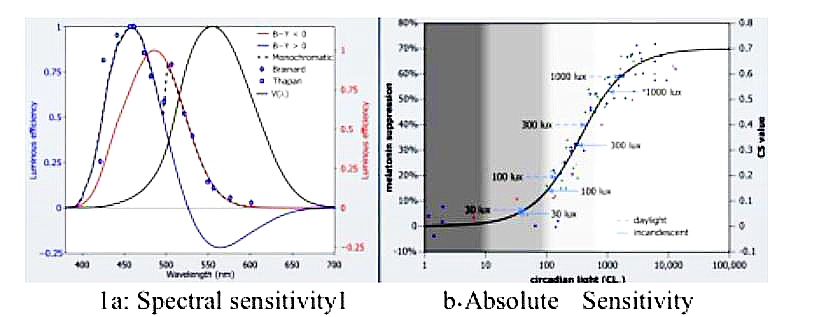
Fig.1 Light have a dual effect on the 24-hour melatonin profile, acute effect and Phase-Shifting effect.
Package design
When you adjust the brightness of conventional halogen
lamp, the color will be changed. However,conventional LED is not able to tune color temperature while changing brightness,emulating the same changing of some conventional lighting. In the earlier days, many bulbs will use led with different CCT LEDs combined on the PCB boardto
change the lighting color by changing driving current. It needs complex circuit light module design to control CCT, which is not easy task for luminaire manufacturer.As the lighting design advances,the compact lighting fixture such as spot lights and down lights,calls forsmall size, high density LED modules,In order to satisfy both color tuning and compact light source requirements,tunable color COBs appear in the market.
There are three basic structures of color-tuning types, the first, it use the warm CCT CSP and cool CCT CsP bonding on the PCB board directlyas illustrated in Figure 2.The second type tunable COB with LES filled with multiple stripes of different CCT phosphor siliconesas shown in Figure
3.Inthis work,a third approach is taking by mixing warm CCT CSP LEDswith blue flip-chips and closely solder attached on a substrate.Then a white reflective silicone dam is dispensed to surround the warm-white CSPs and blue flip-chips.Finally,it is filled with phosphor contained siliconeto complete the dual color COB module as shown in Fig.4.
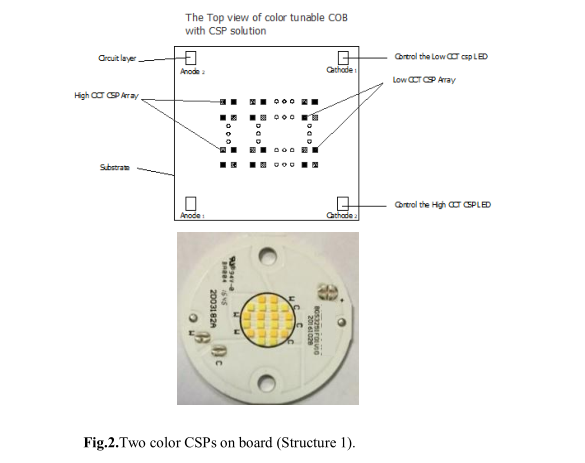
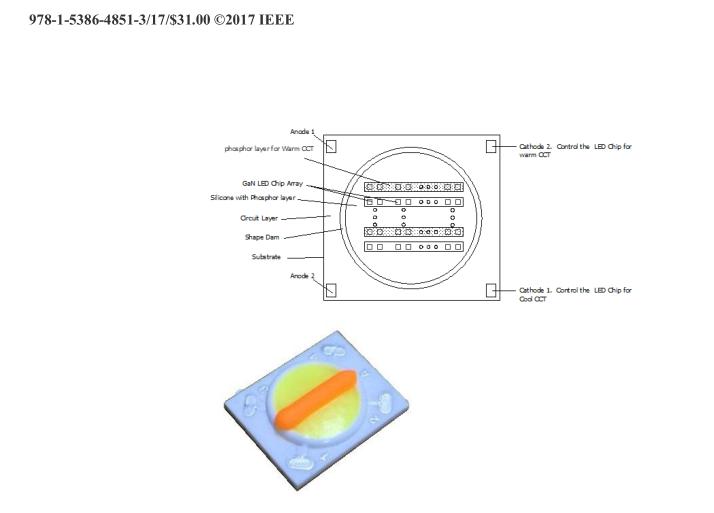
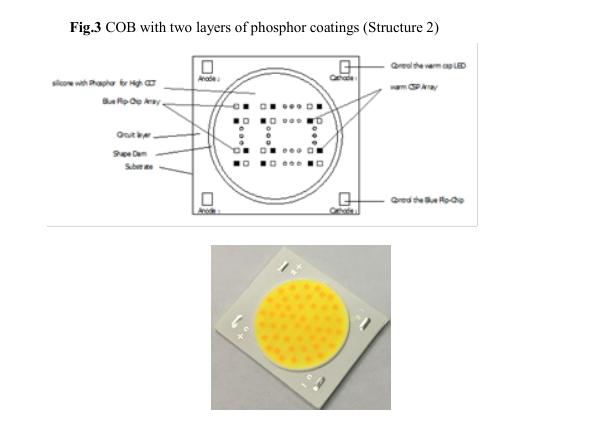
Fig.4 Warm color CSP and blue flip chip COB (Structure 3- ShineOn development)
Comparing to the Structure 3, Structure 1 has three disadvantages:
(a) Color mixing among the different CSP light sources in different CCTs is not uniform due to the segregation of phosphor silicone caused by the chips of the CSP light sources;
(b) The CSP light source is damaged easily with a physical touch;
(c) The gap of each CSP light source is easy to trap the dust to cause COB lumen reduction;
Structure2 also has its disadvantages:
(a) Difficulty in manufacturing process control and CIE control;
(b) Color mixing among the different CCT sections is not uniform, especially for the near field pattern.
Figure 5 compares MR 16 lamps built with light source of Structure 3 (left) and Structure 1(right). From the picture, we can find the Structure 1 has a light shade in the center of emitting area, while theluminous intensity distribution of Structure 3 is more uniform.
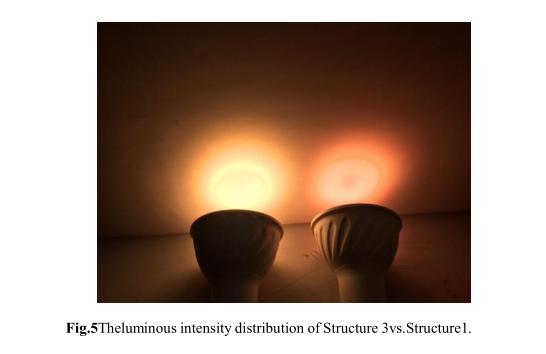
Applications
In our approach using Structure 3, there are two different circuit designs for the light color and brightness tuning. In a single-channel circuit which has a simple driver requirement, the white CSP string and blue flip-chip string are connected in parallel.There is a fixed resistorin the CSP string. With the resistor, the driving current is divided between CSPs and blue chips resulting change of the color and brightness.The detailed tuning results are shown in Table 1 and Figure 6. The color tuning curve of single-channel circuitis shown in Figure7. The CCT increasesas the driving current. We have realized two tuning behavior with one emulating conventional halogen bulband the other more linear tuning. The tunable CCT range is from 1800K to 3000K.
Table1. Flux and CCT change with driving current of ShineOn single-channel COB Model 12SA
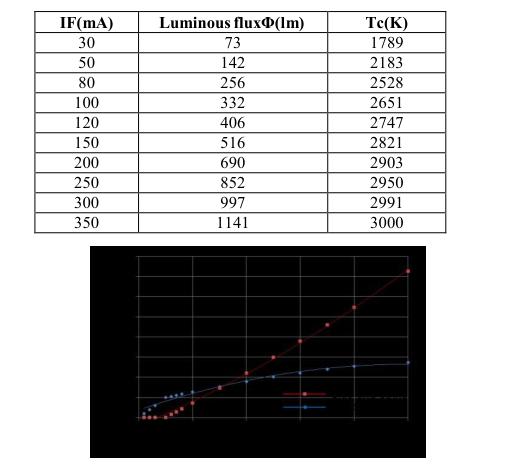
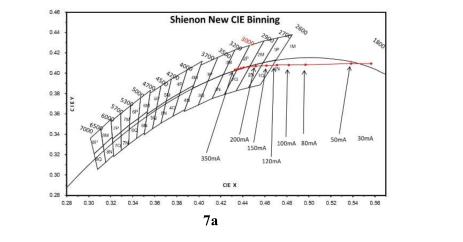
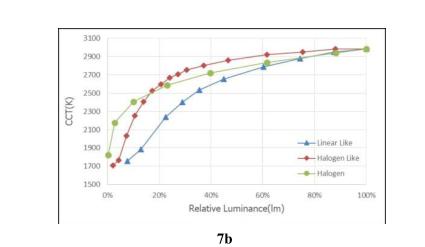
Fig.7CCT tuning along with blackbody curve with driving current in the single-channelcircuit controlled COB(7a) and the two
tuning behaviors with relative luminance in reference to Halogen lamp(7b)
The other design uses a dual-channel circuit where the CCT tunable arrange is wider than the single- channelcircuit.The CSP stringand blue flip-chip stringare electrically separate on the substrate and thus it requires special power supply.The color and brightness are tuned by driving the two circuits at desired current level and ratio. It can be tuned from 3000k to 5700Kas shown in Figure 8 of ShineOn dual-channel COB model 20DA.Table 2 listed the detailed tuning result which can closely simulate the day light change from morning to evening.By combining the use of occupancy sensor and control circuits,this tunable light sourcehelps increase exposure to blue light during the day and reduce exposure to blue light during the night,promoting people's well-being and human performance, as well as smart lighting functions.
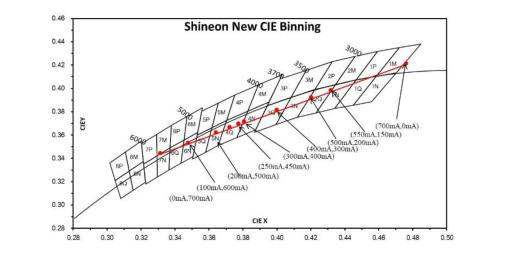
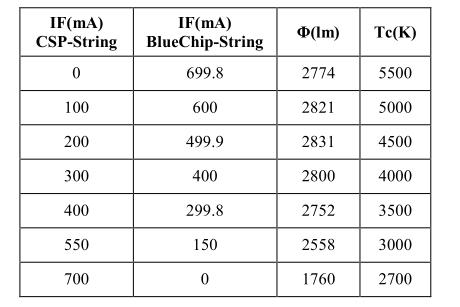
Summary
Tunable LED Modules were developed by combining
chip scale packages (CSP) and chip on board (COB) technology. CSPsand blue flip chip are integrated on a COB board to achieve high power density and color uniformity, dual-channel structure is used to achieve wider CCT tuning in applications like commercial lighting. Single-channel structure is used to achieve dim-to-warm function emulating halogen lamp in applications like home and hospitality.
978-1-5386-4851-3/17/$31.00 02017 IEEE
Acknowledgement
The authors would like to acknowledge the funding from The National Key Research and Development
Program of China (No. 2016YFB0403900). Additionally, support from the colleagues in ShineOn (Beijing)
Technology Co, is also gratefully acknowledged.
References
[1] Han, N., Wu, Y.-H. and Tang, Y,"Research of KNX Device
Node and Development Based on the Bus Interface Module", 29th Chinese Control Conference (CCC), 2010, 4346 -4350.
[2] Park, T. and Hong, S.H. ,“A New Proposal of Network Management System for BACnet and Its Reference Model", 8th IEEE International Conference on Industrial Informatics (INDIN), 2010, 28-33.
[3]Wohlers I, Andonov R. and Klau G.W.,“DALIX: Optimal DALI Protein Structure Alignment", IEEE/ACM Transactions on Computational Biology and Bioinformatics, 10, 26-36.
[4]Dominguez, F, Touhafi, A., Tiete, J. and Steen haut, K.,
“Coexistence with WiFi for a Home Automation ZigBee Product”, IEEE 19th Symposium on Communications and Vehicular Technology in the Benelux (SCVT), 2012, 1-6.
[5]Lin, W.J, Wu, Q.X. and Huang, Y.W,"Automatic Meter Reading System Based on Power Line Communication of LonWorks", International Conference on Technology and Innovation (ITIC 2009), 2009,1-5.
[6] Ellis, E. V., Gonzalez, E. W., et al,“Auto-tuning Daylight with LEDs: Sustainable Lighting for Health and Wellbeing", Proceedings of the 2013 ARCC Spring Research Conference, Mar, 2013
[7] Lighting Science Group White Paper,"Lighting: the Way to Health& Productivity", April 25, 2016.
[8] Figueiro,M. G.,Bullough, J. D.,et al, "Preliminary evidence for a change in spectral sensitivity of the circadian system at night",Journal of Circadian Rhythms 3:14. February 2005.
[9]Inanici, M,Brennan,M, Clark, E,"Spectral Daylighting
Simulations: Computing Circadian Light",14th Conference of International Building Performance Simulation Association, Hyderabad, India, Dec.2015.

